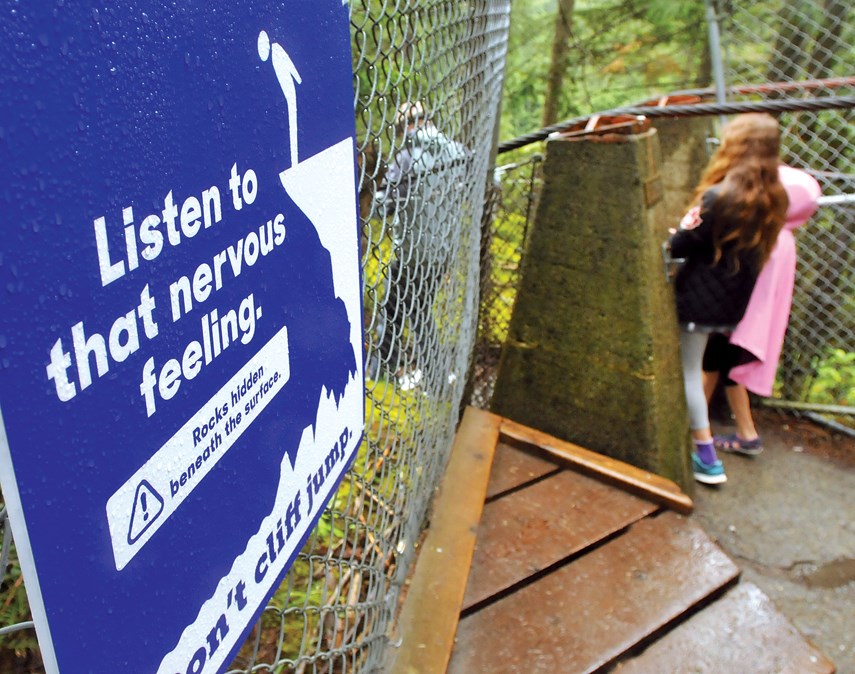The District of North Vancouver is taking a cheekier, more irreverent tone attempting to warn would-be Lynn Canyon cliff jumpers away from the potentially deadly summer activity.
New signs that take a lighter tone and borrow the language youth are more likely to see online have been installed near the fences meant to deter jumpers.
Two of them feature comic-style word bubbles with the phrases “That was worth the spinal damage, said no one ever” and “I’m OK drowning today, said no one ever.” Closer to the cliffs, signs feature the phrases “Listen to that nervous feeling” and “Your fear is way smarter than you” along with stick figures peering down a treacherous drop. Finally, at the cliff’s edge, red diamond-shaped signs depict a figure in distress in the water with the words “Deadly current. Hidden objects. Unsafe conditions. Don’t cliff jump.”
The district is specifically targeting young men, aged 15 to 25, and research shows this type of messaging is more likely to hit home than the old signs using starker, sterner language.
A few examples of the new public safety messaging in #lynncanyon. pic.twitter.com/TKHXf3P4dZ
— Mathew Bond (@mrmathewbond) July 6, 2016
“People were treating them like part of the furniture. It had lost its effectiveness because it had been there for so long,” said Mairi Welman, district spokeswoman. “These signs took a 180-degree different approach, rather than telling people what the rules are, what we thought we’d do is tap into the internal dialogue that people might be having before they go cliff jumping.” she said.
In March, 16-year-old Coquitlam teen Cole Marsh drowned when he slipped into the canyon. It took a multi-agency effort to recover his body, which was trapped under water, more than three weeks later. There was also a fatality last year when an exchange student jumped in the water and was pinned under a rock ledge by the current.
It’s too soon to say whether the signs, which were installed in time for the May long weekend, have persuaded many jumpers but anecdotally, the park rangers report visitors taking pictures of them or having their picture taken next to them and posting them to social media.
“People are talking about it and we’ve had some good feedback on Twitter,” Welman said. “People are noticing them.”
District staff has other strategies they’re hoping to test out at the park over the coming years, though they haven’t come to council for a vote yet. Those approaches will also likely involve social media. Park visits and cliff jumping have been on the rise in recent years as word and images of the cliffs spread on Instagram, Facebook and Twitter.
“We know for instance that 15- to 25-year-olds live on social media,” Welman said.
This year hasn’t been out of the ordinary for the number of injuries and rescues at the canyon, although it has been a bit of a cool start to summer, according to deputy fire chief Wayne Kennedy. Still, District of North Vancouver Fire and Rescue Services members are fully in support of the campaign.
“I think the signs are great. Anytime we have a chance to broaden our message and get it out to a wider audience and educate people, that’s a positive for us. I’d rather have somebody stop and take a look at our signage and actually do an internal gut check,” he said.
Though it’s not likely to stop all cliff jumpers, the district’s logic is absolutely on the right track, according to Mary Charleson, Capilano University marketing instructor and consultant.
“The warning to think about it casts some doubt and that’s probably better than a proscriptive ‘Don’t do it.’ The whole youth rebellion doesn’t like to be told what not to do,” she said.
Charleson also praised the campaign’s short messages and imagery, both of which have been shown to be more effective than a wall of text. And the campaign seems to have the ability to generate some buzz in and of itself.
“There’s nobody on the North Shore who wants see another headline this summer about a youth drowning. If it gets attention and gets people talking, honestly, that’s half the battle and that appears to be the case here. It’s getting media attention,” she said.



